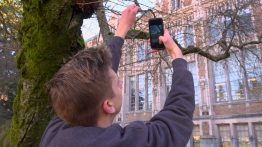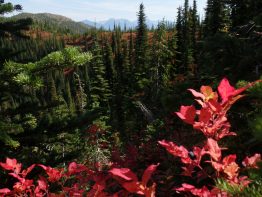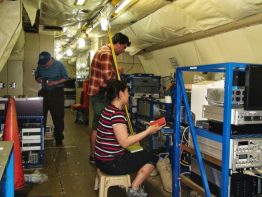In a paper published April 1 in the Proceedings of the National Academy of Sciences an international team of authors, including University of Washington Provost Mark Richards, share the discovery of a site that tells another piece of the story from the day a meteor strike is thought to have led to the end of the dinosaurs. “It’s like a museum of the end of the Cretaceous in a layer a meter and a half thick,” said Richards, who is also a professor in the UW Department of Earth & Space Sciences.
Read more »UW students spearhead efforts to predict peak bloom for cherry trees
Each spring, thousands of visitors flock to the University of Washington campus to see the iconic cherry trees in the Quad. Class discussions, casual Frisbee tosses, lunchtime picnics and even wedding portraits all take place under the beautiful blossoms, which typically hit their prime in late March or early April. This year, they reached peak bloom on March 29. But there’s no easy way to predict when peak bloom will occur each year for the trees in the Quad.
Read more at UW News »UW tool maps huckleberries to help find endangered grizzly bears
A team of researchers from the University of Washington and U.S. Geological Survey have made used satellite images of Glacier National Park, to examine patterns in huckleberry plants that turn a brilliant red color each fall. Tracking where huckleberry plants live now — and where they may move under climate change — would help biologists predict where grizzly bears will also be found.
Read more at UW Today »Air quality agencies can breathe easier about current emissions regulations
As air quality improves, the invisible chemistry happening in the air around us is changing. Skies should clear up as emissions drop, but recent results suggested that declining nitrogen oxides can create an environment where airborne carbon-containing compounds more easily convert into small particles that harm human health. Regulators can now breathe easier. A University of Washington-led study, published in March in the Proceedings of the National Academy of Sciences, provides a fuller picture of the relationship between nitrogen oxides — the tailpipe-generated particles at the center of the Volkswagen scandal, also known as NOx, — and PM2.5, the microscopic particles that can lodge in lungs.
Read more at UW News »Bubble streams off Washington’s coast provide clues to what will happen during a major earthquake
Off the coast of Washington, columns of methane bubbles are being squeezed out of sediment and rising up through the water. A study by the University of Washington and Oregon State University suggests that the locations of these bubble plumes provide important clues to what will happen during a major offshore earthquake. Analysis of the underlying geology suggests that the bubbles emerge here because of the gas and fluid rising through faults which are generated by the motion of geologic plates—the same plates that produce major offshore earthquakes in the Pacific Northwest.
Read more at UW Today »





